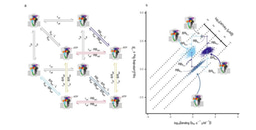Why do wild chimpanzees possess large tool kits?
Published in Ecology & Evolution and Behavioural Sciences & Psychology

“Xela, an adult female chimpanzee is expertly cracking panda nut (one of the hardest nuts in Africa) on the roots of a tree, using a large stone as a hammer. After cracking open one of the nuts, she breaks a stick and uses it as a spoon to extract the remaining pieces of kernel trapped in the shell. This action catches the attention of her granddaughter, Xian, a near 4-year-old chimpanzees sitting nearby. After observing Xela, Xian quickly moves to the side, picks up an empty shell from the ground, and begins making her own tool before inserting it into the hollow shell.”
Such tool-use behaviors are common among chimpanzees from the Taï forest (Cote d’Ivoire). In fact, after humans, some chimpanzee populations possess the most extensive tool-use repertoire. They use leaves to extract water from holes, modify sticks to retrieve various foods from their substrates, and crack nuts using stones or pieces of wood.

Figure 1. Young chimpanzees observing the activity of older individuals in several contexts, including tool use. (Photo credits: Images 1, 2, 3, 4, and 6 – Liran Samuni; Image 5 – Oscar Nodé-Langlois; Taï Chimpanzee Project.)
In humans, tool use often relies on social learning and is believed to be supported by cognitive skills inherited from a strong dependence on social learning. Among other factors, access to diverse tolerant role models during an extended developmental period is thought to be crucial.
To investigate the extent to which chimpanzees rely on observational social learning—and how factors such as prolonged development, social tolerance, and access to diverse role models influence learning opportunities—we studied young wild chimpanzees from the Taï forest and recorded all instances of immature closely observing other group members. For examples, see: https://youtu.be/FBOpYsf7shg?si=z1jbqTCMfJpQAchu
To answer these questions, I worked with three other students to collect data on young chimpanzees in Taï National Park as part of the Taï Chimpanzee Project, which has been studying this population for over 45 years. Together, we gathered data on more than 35 chimpanzees aged 0 to 10 years, accumulating over a thousand hours of observation.
Fieldwork comes with many challenges. For instance, in 2022, likely due to weather conditions, coula nuts—the most commonly cracked using tools by chimpanzees—were particularly scarce. As a result, we decided to collect additional data in 2023. These data enabled us to look at the development of social learning opportunities in several contexts, including tool use, while controlling for many factors.

Figure 2. Several chimpanzees observing a male using a stick to collect honey. (Photo credit: Liran Samuni, Taï Chimpanzee Project)
After analyzing the data, our results revealed that young chimpanzees frequently observe others to acquire technical skills, particularly for complex tasks such as tool use. We recorded over 50 different contexts in which this occurred, suggesting that a significant portion of chimpanzees’ feeding behavior is socially influenced.
Additionally, we found that, like humans, chimpanzees rely on observational social learning for at least the first decade of their development. They show a particular interest in food items they are not yet able to process, which may partly explain why offspring remain closely associated with their mothers long after weaning.
While young chimpanzees often relied on their mothers early in development and for mastering complex tasks, they also observed various other group members. They showed a preference for older, spatially tolerant role models—likely the most experienced individuals.
These findings highlight key factors influencing learning opportunities. They suggest that, as in humans, prolonged development, social tolerance, and access to diverse role models enhance social learning opportunities in wild chimpanzees. These elements may have played a crucial role in human evolution, expanding learning opportunities and exerting selective pressure on cognitive abilities that facilitate tool use.

(Illustration credit: Oscar Nodé-Langlois, Taï Chimpanzee Project)
Follow the Topic
-
Communications Biology

An open access journal from Nature Portfolio publishing high-quality research, reviews and commentary in all areas of the biological sciences, representing significant advances and bringing new biological insight to a specialized area of research.
Related Collections
With Collections, you can get published faster and increase your visibility.
Cancer Cell Atlases
Publishing Model: Open Access
Deadline: Jan 15, 2026
Lipids in Cell Biology
Publishing Model: Open Access
Deadline: Mar 03, 2026




Please sign in or register for FREE
If you are a registered user on Research Communities by Springer Nature, please sign in